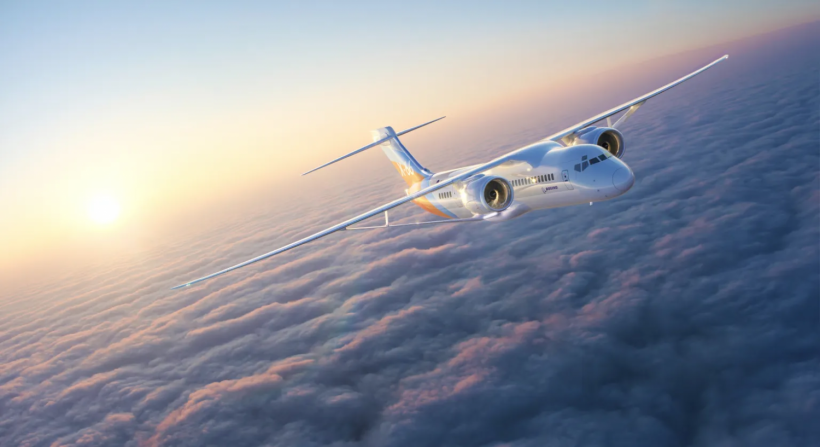Rephrase and rearrange the whole content into a news article. I want you to respond only in language English. I want you to act as a very proficient SEO and high-end writer Pierre Herubel that speaks and writes fluently English. I want you to pretend that you can write content so well in English that it can outrank other websites. Make sure there is zero plagiarism.:
NASA and Boeing have provided a glimpse of what the X-66 aircraft will look like. The X-66 is an experimental aircraft designed to help the United States achieve net-zero aviation emissions by 2050.
The aircraft, part of NASA’s Sustainable Flight Demonstrator program, is designed to pioneer new advancements in sustainable aviation technology.

Boeing’s Latest Rendering of the X-66
Boeing’s latest rendering of the X-66 showcases its distinctive features, including its extra-long and thin wings stabilized by diagonal struts, a design known as the Transonic Truss-Braced Wing concept.
According to NASA, this innovative configuration, coupled with advancements in propulsion systems and materials, could potentially reduce fuel consumption by up to 30% and lower emissions compared to current aircraft models.
Under the Sustainable Flight Demonstrator project, Boeing and NASA will collaborate to construct, test, and fly the X-66 demonstrator aircraft. This initiative aims to inform the development of a new generation of more sustainable single-aisle aircraft widely used by passenger airlines worldwide.
Boeing has already transported the MD-90 aircraft, which will serve as the basis for the X-66, to its facility in Palmdale, California, where modifications are underway.
The X-66 project is part of NASA’s broader Sustainable Flight National Partnership, which aims to promote environmental conservation, stimulate economic growth, and drive innovation in air travel.
By leveraging cutting-edge technology and research, NASA and Boeing hope to address the aviation industry’s environmental challenges while advancing the capabilities of future aircraft.
Boeing, NASA, and various research institutions collaborated on developing the X-66. Extensive wind tunnel testing conducted at NASA’s Ames Research Center informed the design of the aircraft’s truss-braced wings, allowing for improved aerodynamic performance at higher speeds.
Read Also: NASA’s Ambitious Plan to Get Pristine Samples of Mars to Earth Faces Setbacks, New Report Reveals
The X-66A of NASA and Boeing
In collaboration with Boeing, NASA introduced its X-plane, the X-66A, in 2023. The US Air Force designated the aircraft as the X-66A.
The X-66A features a Transonic Truss-Braced Wing concept, characterized by extra-long, thin wings stabilized by diagonal struts. This innovative design seeks to revolutionize the workhorse of passenger airlines worldwide, the single-aisle aircraft, by making it greener, cleaner, and quieter.
Earlier, NASA Administrator Bill Nelson expressed the agency’s commitment to advancing aviation and addressing climate concerns. He said the X-66A “will help shape the future of aviation, a new era where aircraft are greener, cleaner, and quieter, and create new possibilities for the flying public and American industry alike.”
The primary objective of the X-66A is to support the US in achieving net-zero greenhouse gas emissions in aviation, aligning with the goals outlined in the US Aviation Climate Action Plan. The aircraft represents a significant step toward reducing aviation emissions, intending to reach net-zero emissions by 2050.
By integrating the Transonic Truss-Braced Wing configuration with advancements in propulsion systems, materials, and systems architecture, the X-66A aims to achieve a remarkable 30% reduction in fuel consumption and emissions compared to existing leading aircraft models.
Related Article: NASA’s CUTE Mission Discovers Thousands of Extreme Exoplanets Despite Spacecraft’s Compact Size
ⓒ 2024 TECHTIMES.com All rights reserved. Do not reproduce without permission.

I have over 10 years of experience in the cryptocurrency industry and I have been on the list of the top authors on LinkedIn for the past 5 years. I have a wealth of knowledge to share with my readers, and my goal is to help them navigate the ever-changing world of cryptocurrencies.








